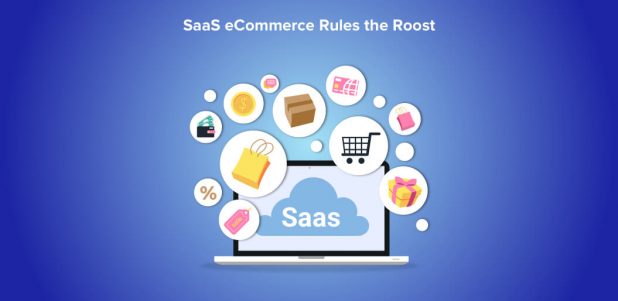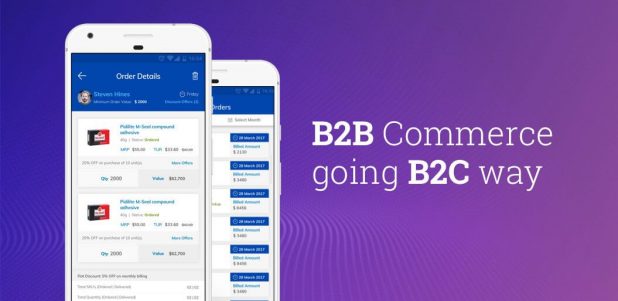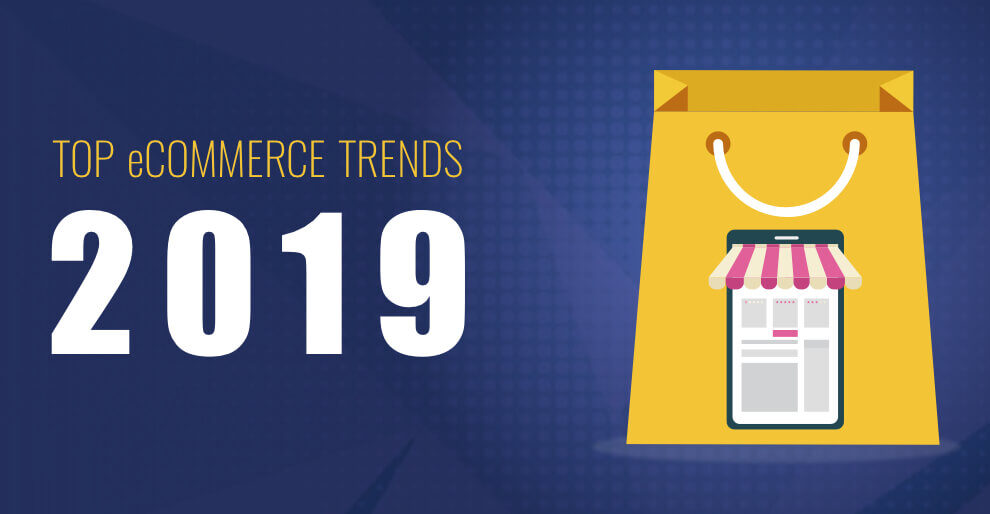There’s only one thing that’s constant in this universe – change. eCommerce is no exception to this belief. 2019 is here, and new changes are about to happen in the eCommerce space. Lest you lag behind, we’ve listed the top 11 eCommerce trends for 2019.
While not all of them are recent, there are some that will hit the industry for the first time.
Let’s get on with what 2019 has in store for us.
Progressive Web Apps Transform the UX

It’s time to blur the distinction between eCommerce websites and apps; it’s time for PWAs (progressive web applications). This is the new standard of going about the dual business of capturing your audience on the web as well as on mobile. PWAs are best of both worlds and the worst of neither.
We’re talking about 10 times faster load time, offline capabilities, push notifications, and much more. With these, brands can achieve a native-like experience while removing the need to make a separate mobile app in addition to a desktop app.
The Imperative
The world is quickly shifting to PWAs, since they are native-like and don’t have the downside of cross-platform apps, and so should you.
Voice Search and Home Assistant will Become Mainstream

Shortcuts just got shorter with voice search (Siri, Google Assistant) and assistants like Amazon Echo, Google Home, Apple Homepod, etc. According to The Verge, “39 million Americans reportedly own a voice-activated smart speaker”
These are adding one more channel to omnichannel eCommerce that is operating full-throttle already. The Voice savvy customer experience has already taken over the American market. According to Voicebot.ai, the sale of food takeaways, groceries, books, and homecare items through voice-activated devices are very much happening and inspiring new customers to take this route.
The Imperative
Integrating voice search into your website and app and optimizing them is your next step.
The easiest way to get into the smart home voice assistant market right now is to launch an Alexa Skill. Choose a headless digital experience platform to add this new channel and manage it constantly.
SaaS eCommerce Rules the Roost

Talking of saving time, it is speed and stability that are going to be your saving grace. Saas ecommerce platforms are going to grant you that. Take a cue from the best ecommerce brands like Amazon.
The advantage is that SaaS eCommerce popularity will cause (in fact, is causing) providers to keep on adding better features, resulting in better sales and marketing management.
The Imperative
SaaS is becoming more popular than ever, and so there is no better time to join it. As new channels of eCommerce sales emerge, SaaS is just the eCommerce model that’s going to give you an edge. If you haven’t taken note of this rising ecommerce trend already, please do, and please execute.
Shoppable Videos are the New Face of eCommerce

Yes, video was among the top eCommerce trends of 2018, but the storm that video created continues to disrupt the eCommerce space. It is estimated that videos will fetch around 80% of total web traffic this year.
Brands have now taken a fancy to videos and are experimenting with videos in the form of short brand films, animation, product videos, FAQs, and even testimonials, thus strengthening their brand message through interactivity and engagment. Videos are also proving to be instrumental in increasing conversion rate and reducing the order return rate.
The Imperative
Video is one of the most important current trends in eCommerce that you cannot afford to leave unexplored. Be creative and use videos to strike a connection with your customers. Break from the beaten path and see how you can use video to set your products apart from the crowd.
Image Search

This one is an entire game changer in the custom eCommerce development niche, and the eCommerce market as a whole. This trend will set apart image search enabled eCommerce applications from the ones that aren’t.
It is one of those recent trends in eCommerce that will empower users. It will allow the user to refine search as much as possible in contrast to the keyword-based search where the query results are only as accurate as the user’s ability to describe a product. The engine’s recommendations for viewing similar items also point to the “don’t make me think” rule.
The Imperative
Integrate image search functionality to your web and mobile app to make search more user-friendly and boost keyword search by providing users a context to make better searches.
B2B will Be More Like B2C

This time around, it’s the turn of B2B eCommerce to grow by leaps and bounds like B2C. The proliferation of new digital channels will expand the markets for B2B eCommerce and make the outreach to the target audience. The state of B2B eCommerce has been encouraging and is likely to be even better in 2019.
According to Forrester,
“By 2020, B2B eCommerce is estimated to grow to $1.1 trillion and contribute 12.1 % of total B2B sales in the US.”
The Imperative
B2B is certainly growing like B2C. Expand your horizon and think about the newer channels that you could use to reach your target audience. Develop a strategy for the same. Take a cue from Alibaba. Consider your business customers as individual customers in terms of catering wholesome shopping experiences.
Pay Like You Want – Newer Payment Methods Like Cryptocurrency Soar

Cash on delivery is almost passe now, and a spectrum of payment method options rule the eCommerce space. Apart from debit and credit cards, users are now becoming comfortable with instant layby (ZipPay, Afterpay) and digital wallets like Google Pay, Apple Pay, etc..
And it’s time to familiarize yourself with cryptocurrency (Bitcoin). It is certainly one of the new trends in eCommerce.
All these newer payment method options have empowered the customer to buy with or without a deposit at that particular point in time, helping them achieve instant gratification with the least friction.
Long forms slow down the conversion process; quick payment methods speed it up by more than 20%.
The Imperative
Integrating better, modern, payment methods, is not a choice. It’s the norm, while cryptocurrency is a choice that you may want to consider. Who knows, it may figure among the list of eCommerce trends 2020.
The bottom line is to empower your customers with a seamless purchasing process.
The Love for Machine Learning and Artificial Intelligence Gets Deeper

Creating more focused and fulfilling experiences, as well as more successful marketing campaigns, is what I am talking about. Artificial intelligence, as well as machine learning, works towards this goal.
Both artificial intelligence and machine learning are the force behind chatbots and recommendation engines. With them, customer segmentation becomes easy and allows you to analyze customer behavior and preferences to make product and offer recommendations for a personalized experience, apart from allowing you to automate customer service.
One use of machine learning that not many businesses take into account is identifying anomalies in the mounds of data that eCommerce procures from customers and sales. Fraud detection is one great use of machine learning in eCommerce.
The Imperative
Right now, it’s time to familiarize yourself with these eCommerce technology trends that are going to rule the future of eCommerce, beginning with adding chatbots and recommendation engines.
AR and VR are Ready to Change the Game

Augmented Reality and Virtual Reality are blurring the lines between the physical and the virtual and enabling customers to explore products outside of brick-and-mortar stores like never before.
Brands like Walmart are already investing generously in AR for providing out of the ordinary browsing and shopping experiences to their customers while they are in the consideration phase.
IKEA, in fact, took it to the next level with its app called Space which lets you use AR to place furniture into your space so you can decide if it’s the right choice and the right fit.
While AR is pretty much progressing and easier to implement by eCommerce companies, VR is still in its nascent stage, but is now finding ample use in the travel and real estate industries.
VR is now able to offer a 360-degree teaser view of the place that customers are looking to visit. Customers looking to buy or rent a property can have an inside look without having to be there in person. Best Western is actually implementing VR in their chain of hotels.
The Imperative
While the idea is tempting and this new eCommerce trend might just become the norm soon, the imperative right now is to find a use case for AR and VR for your business.
Customer Services is Better Automated with Chatbots

Chatbots are moving at full throttle and are on their way to becoming a staple in eCommerce website development. Much as users love to solve a problem with a simple chat, AI is coming to the rescue to save users from getting engaged (often for a long time) on phone calls with support people. Chatbots resolve the same problems in less time and with much fewer resources.
Chatbots, contrary to some, are not depersonalizing customer service, but are actually streamlining it in a much better way than humans can. They are great at finding the right answer for queries and grievances, and also for connecting customers to the right support people when needed.
The Imperative
Invest in automating your customer service through chatbots. They are the best way of not only saving your customer’s time but also providing a personalized experience.
Personalized Experience Persists

According to research by Dynamic Yield, “9/10 shoppers believe that mobile shopping experiences can be improved.”
Personalization is just that key you need to unlock your customers’ emotions. Personalization isn’t a new idea. It was, in fact, one of the top ecommerce trends of 2018. And incidentally, Amazon has attributed around 35% of their total sales revenue to the product recommendations that its engine makes to its customers.
Most of your prospective customers are keen on saving time in their busy lives. They‘d rather choose a way to shop that saves effort and gives them what they need in a jiffy.
When a majority of customers think that eCommerce websites and apps could offer them better experiences, personalization is the rule of thumb rather than a trend you should follow.
The Imperative
Providing personalized experiences in the form of product and offer recommendations, based on the customer’s journey, preferences, and behavior is the way to go in attracting and retaining customers.
The Takeaway
eCommerce, in this decade, has grown by leaps and bounds, especially with the spike in the number of mobile device (smartphones in particular) users. As the trends in digital devices and user behavior change, so do the trends in eCommerce.
Getting on board with these 2019 eCommerce trends can do a lot to attract and keep your customers. Keep on top of these trends and keep experimenting.





